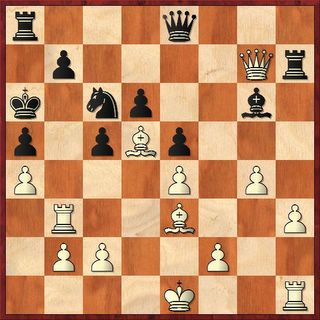2000 Bottom-Half Class Championships R2
Best Western, Ann Arbor, MI, 7.2.2000
Philidor Defense: Steinitz Variation [C41]
This is a game from my second tournament. It wound up being the the first one that was rated for me. I was playing in an unrated section, however one of the players had played some scholastic chess 7 years prior and obtained a rating of 528. Anyhow, I finished the tournament with 4.5/6, but with a rating of only 1103.
1.e4 e5 2.Nf3 d6
First and only Philidor Defense for me.
3.Bc4 Be7
In those days I was oblivious of many of the opening rules of thumb. Here I violated the knights before bishops rule. However, this is the correct move in the Steinitz Defense. The Lopez counter-gambit is 3. ...f5.
4.Nc3 f5
And here I violated a rule I teach all of my students these days, "No pawn moves in the opening aside from the d or e pawn, unless you have memorized a line from a book." The move f5 is not bad all by itself, but with the white light square bishop posted on c4 there wil be no kingside castle for a long time. Furthermore, a queenside castle is probably even farther off since there has been no queenside development.
5.d3 fxe4
Nc6 looks correct to me here. Black is behind in development, and all this pawn exchange does is open lines for the white queen.
6.dxe4 Bg4
Black could have fought for control of the d5 square by playing c6. Now he is in for a world of hurt.
7.Qd5 Nf6 8.Qf7+
White had his choice of which side to attack from. Qxb7 requires the black reply Nbd7 to avoid losing the a8 rook.
8...Kd7 9.h3 Rf8
I remember being afraid of playing Bxf3 because of how uncomfortable my king would be after Be6+.
10.Qxg7 Bh5 11.Ng5 Qe8 12.Nd5 Nxd5
My goal at this point was to trade resources and try to survive this onslaught. A better plan would have been to trade pawns, not pieces and in the meantime keep developing. So Nc6 would have assisted in the defense of the king far more than NxN. 13.Bxd5 c6
Not only did c6 take away the outpost on d5, but it also provided an escape square (b6) if I needed it later.
14.Be6+ Kd8 15.Nxh7 Rh8 16.Nf6 Bxf6 17.Qxf6+ Kc7 18.g4 Bg6 19.Qg7+ Kb6
Ugly move, but black has nothing else.
20.Be3+ c5 21.a4?
This move gives black a chance to regroup. White keeps the pressure on with O-O-O hitting the d6 weakness. Notice that the bishop on e6 is not hanging as long as the rook on h8 is only protected by the queen. Ultimately the idea of a4-Ra3-Rb3+ is too slow for the position.
21...Nc6?? Bxe4 attacking the rook gives black some initiative. Moreover, this would remove the d5 outpost. White probably responds with a5+, forcing Kc6, but then he has to deal with the attack on his rook. Unless, of course, he notices the skewer potential along the a4-e8 diagonal and play Bb3.
22.Bd5 a5 23.Ra3 Ka6??
Rh7 was black's only move.
24.Rb3 Rh7??
This is too late!

White to mate in 4. Can you find the combination Derderian missed?
25.Qf6?? One good blunder deserves another, however, it can be psychologically difficult for a player to ignore a threat to his queen. Bc4+ starts the mating combination. Can you find the rest of it?
25...Rd8 26.Rb5 Bf7 27.Bd2 Bxd5 28.exd5 Nb4
Both sides have played relatively accurately since the last blunder.
29.c3
White has a tremendous position. He should probably just trade off the knight for the bishop. Then he can take advantage of his connected passed pawns on the kingside. This move at the very least gives away a pawn.
29...Nxd5 30.Qf5 Rf7 31.Qd3 Nf4 32.Rxc5+??
A miraculous blunder! White has the game essentially won, yet now a small miscalculation costs him the game. Incidentally, black has forced mate in 8. 32...Nxd3+ 33.Ke2 Nxc5
Black captures a second piece thanks to the blunder on move 32. Ironically, this capture was not accurate, even though it leads to a relatively easy win for black 34.h4 Qxa4 35.g5
The move Qe4+ forking the king and rook had to be prevented. b4 or Be3 are two ways of doing that. Moving the rook is another.
35...Qe4+ 36.Be3 Qxh1 37.Bxc5 dxc5 38.g6 Qd1+ 39.Ke3 Qd3#
This was just one of the three ways that black could had checkmate in 1. 0-1

No comments:
Post a Comment